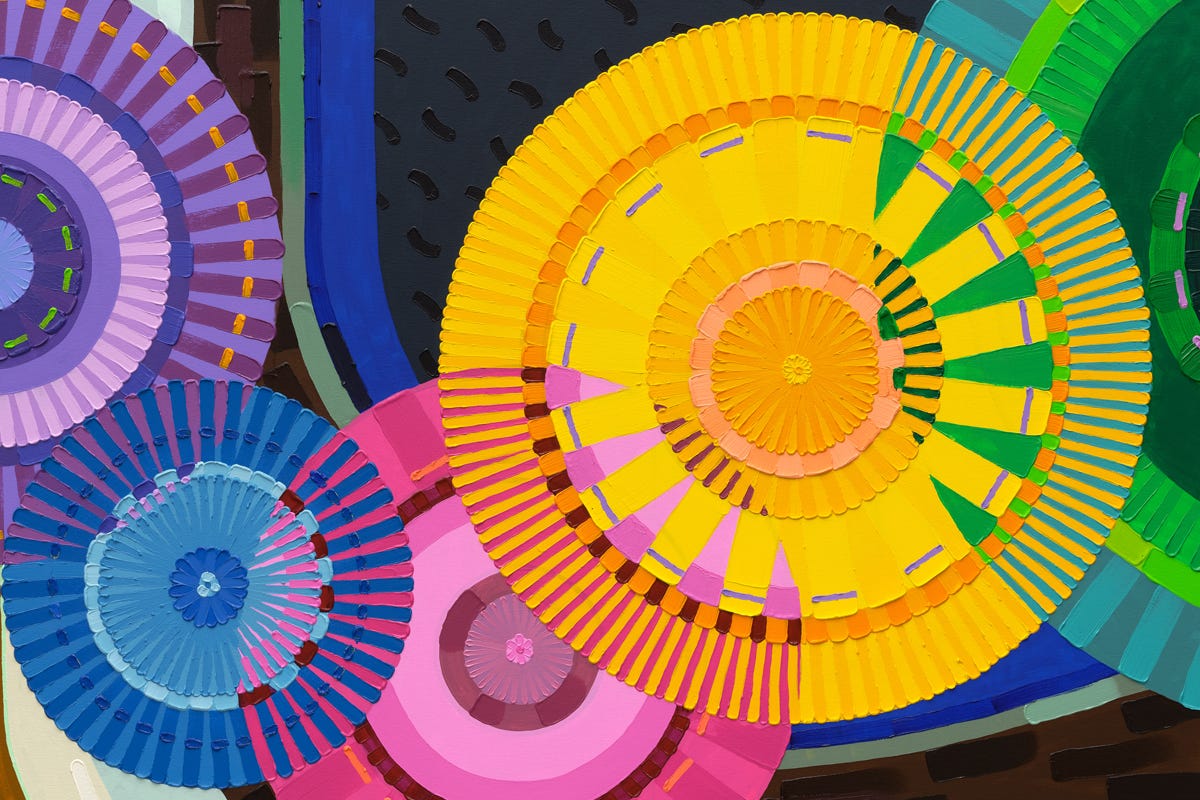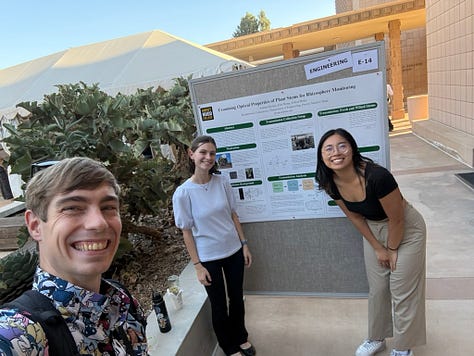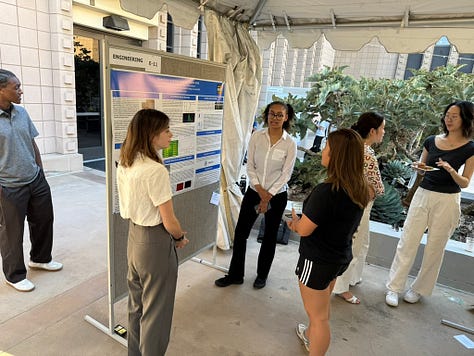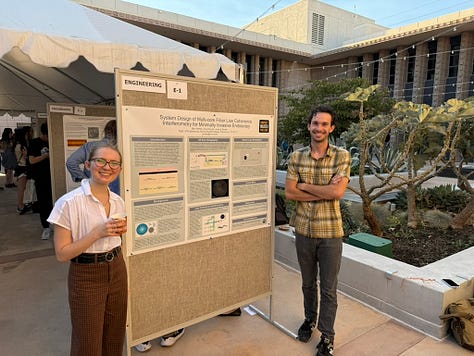Experience and Extend
How the generosity I've been shown humbles me and motivates me to pay it forward
Earlier this year I wrote an essay for the fall issue of Virtues & Vocations Magazine on the theme of generosity. I’m thankful that they were willing to let me share that essay with you here. You can find the original version along with the other contributions in this fall’s issue here.
The generosity of others has played a significant role in my life. I think a lot about how my work serves to multiply that generosity and extend it to others. I hope that you might also consider the generosity you’ve been shown and how that might encourage you to pay it forward to the people around you.
We live in a world obsessed with accomplishment and credentials. But our actions are only a small part of what has gotten us to where we are. It is wise for us to stop to recognize just how many of our accomplishments are downstream of what others have done for us.
Thank you for being here. As always, these essays are free and publicly available without a paywall. If you can, please consider supporting my writing by becoming a patron via a paid subscription.

When I arrived in Longview, Texas to attend LeTourneau University in the fall of 2010, I had only the faintest notions of what I wanted to do with my life. As a kid, I loved to work with my hands and build things. Coupled with a budding love for math and science, I began a journey to explore engineering.
I still remember that first semester. The Advanced Placement courses I had taken in high school enabled me to jump right into the gateway course for the electrical engineering concentration: Electric Circuits I. Circuits I was no picnic, in large part due to the man who had developed and taught the class for the last forty years, Dr. Bill Graff. Bill somehow held together the personas of the quintessential grandpa and the professor with ruthlessly high expectations for his students. Bill famously had a t-shirt with “I fight grade inflation!” emblazoned on the front.
Circuits felt like drinking from a firehose. We quickly learned that the “pop quizzes” on the first few days of class would stop surprising us. It was more shocking to not come into class to meet a quiz in the first few minutes. As I labored through Circuits that semester, I developed a love for the course. Solving the problems was fun, and I loved the way that the theory was reinforced with the hands-on lab exercises we would do each week, building and testing circuits on breadboards.
What I didn’t realize at the time was that Electric Circuits would be the start not only of my craft as an engineer, but as an educator as well. At the end of the semester, one of my friends recommended me as a Supplemental Instructor (SI) for the course the next semester. SIs helped support students in the class by offering recitations and study sessions a few times a week, reinforcing topics from lecture and offering space for students to ask questions in a more relaxed environment.
But the best part of being an SI for circuits was getting to apprentice with Dr. Graff. After a few semesters as the SI for circuits, I began to recognize some common problems faced by students when moving from theory to practice. In response, I compiled a small booklet of problem-solving approaches to help students develop a more intuitive approach to the problems they encountered. I showed it to Bill and he loved it, offering to connect me with his contacts at McGraw-Hill to explore potential routes to have it published. Bill saw something in me. He took the time to see me and consider how he might help encourage me to continue pursuing an area where he saw potential. He shared his network with me, enabling me to self-publish my little booklet through McGraw-Hill and add an ISBN-coded book to my resume.
As much as I learned from Bill in class, the most significant ways I benefited from knowing Bill were relational and not academic. His example and influence taught me what it looks like to develop the lasting impact that I desired for my own career. And his generosity was a key part.
My experiences with Bill convinced me that we often lose sight of the power of simple, consistent acts of generosity. I am willing to bet that if you ask anyone about their most meaningful educational experience, they will almost invariably respond not with a particular skill they learned, place they went, or project they worked on, but with a relationship. Most of the time, that relationship was formational because a teacher, coach, mentor, or family member gave them their time and attention. Even more importantly, that person likely gave them something they didn’t deserve, seeing something in them and going above and beyond to pour into them.
Generosity is at the heart of those formational experiences. As I reflect on the person I want to be, I can’t help but see the influence of the generosity of others on the shape of my development as a person. Almost every significant inflection point in my life has been downstream of generous relationships: parents who provided for my physical and emotional needs as a child, teachers who helped cultivate in me a love for learning, professors who gave me their time and attention as I continued to hone my craft, and mentors who shared their networks with me.
The deep impact of the generosity that I’ve experienced created the desire to extend that same generosity to others. I certainly want to help my students build the skills and character that will help them to access fulfilling vocations. But I also want them to understand that a fulfilling career is not something you can earn or deserve. Rather, it is something that you hold with an open hand, even as you strive to pursue excellence to the best of your ability.
Unfortunately, the orientation of much of our culture is built on the often-unstated assumption that relationships are fundamentally transactional. We are always running cost-benefit analyses in our heads and trying to figure out if the return on what we give will be worth it. This transactional view of the world reinforces the idea that our accomplishments have been earned by our own efforts. This blinds us to the many ways in which our achievements have been significantly influenced by the generosity of others who have extended their own resources on our behalf.
Hard work matters. And yet, if we want to maximize our impact on the world, we need to focus beyond what we do. In a world increasingly focused on transactional relationships where we are seeking our own good, we desperately need a renewed vision of the ways we have been the recipients of the generosity of others. Then, in response to the generosity we have experienced, we can see our own resources as a gift that is not for ourselves, but rather as one to be shared generously with the people around us.
As I continued my studies at LeTourneau and began to consider graduate school, I was at yet another juncture in my career trajectory. Generosity once again played a pivotal role. I had excelled at LeTourneau, but getting into a top-tier graduate school is never a slam dunk, especially when you’re coming from a place that people might mistake for a French cooking school.
I sent in all my grad school applications and the waiting process began. After submitting them, I reached out to some potential future advisors. After a promising phone interview, I noticed that this same professor had a talk at the optics conference in San Francisco where I was presenting my undergraduate research. I emailed to ask whether I could grab coffee with him. He emailed me back and volunteered to do one better, offering to fly me down to Caltech for a day to visit with his group. I was ecstatic.
It rained the day I visited Caltech, ironically enough, for what felt like the last time during my five-year tenure there. Despite the rain, I had a great day, getting to experience firsthand the place that would be my academic home for the next five years. I got to meet the professor who would be my PhD advisor and spend time with the members of his research group, many of whom would be formative pieces of my graduate school experience. All of this was enabled by an act of generosity; time and attention out of a busy schedule to give a kid from a small college in East Texas that he had never heard of a chance.
These experiences of generosity shape the influence I want to have on my students. Recognizing the role that generosity has played in my life breaks down any misconceptions about my accomplishments as the direct product of my own merit. Generosity requires that we loosen our grip on a meritocratic view of our world—the idea that the places we’ve gotten in our lives and careers are the result of our own efforts alone. Our lives are deeply shaped by the opportunities and resources that others have provided to us. And yet, we so easily forget this.
Recognizing the generosity of others also has another effect. It encourages us to consider how we might extend generosity to others. Extending generosity doesn’t happen by accident. The ability to see and respond to opportunities for generosity requires intentional preparation.
One of my favorite examples of this concept in practice is in the story of the famous New York City restaurant, Eleven Madison Park. The story, told in restaurateur Will Guidara’s book Unreasonable Hospitality, follows Guidara’s quest to create the world’s greatest restaurant. The core of his thesis is that exceptional food is not enough. What matters most is the experience. The feats that Will and his staff pulled off are unbelievable—from creating a fake beach experience in the restaurant for guests who had their trip to the oceanside scuttled to buying sleds for a family from Spain experiencing their first snow while they were visiting the city. Will’s obsession with curating the customer experience at Eleven Madison Park was the fuel that propelled it to the top of the restaurant world. At its root, Eleven Madison Park’s success was built on a culture of generosity. While these experiences require financial resources, the money was not what made them happen. Instead, the impact of these experiences was birthed out of generosity—starting with the gift of the attention necessary to see another person and followed by the material resources to create something magical.
As I think about extending generosity to those I interact with, I’ve learned a few things from my own experiences and from the stories of others like Will Guidara. The first thing is that generosity is downstream of intentional preparation. While generous actions may be spontaneous, they require forethought and resources. These resources take time to build, and require that we intentionally create margin in our days so that we can exercise generosity when the moment presents itself.
In my life, I want to maintain a margin in order to create opportunities for generosity. Whether that is time on my calendar or dollars in my bank account, I want to intentionally earmark resources for me to give generously. Without specifically allocating these resources as supplies for generosity, they will naturally be devoted elsewhere.
The second reflection is that authentic generosity requires attention. As we interact with the people around us, we can only demonstrate generosity if we are paying attention—hearing and seeing them and specifically looking for opportunities to be generous. The most generous gifts are given without being requested. To be generous with our resources, we need to be looking to see how they might best be given to those around us.
Unfortunately, cultivating margin and attention is swimming upstream against the currents of our culture. In a world where we’ve built our technology to monetize and capture as much of our time, money, and attention as possible, building the capacity to unlock our potential for generosity is increasingly difficult. With the continuing march of technologies like generative artificial intelligence, we are likely to continue to move toward increasingly transactional relationships.
The good news is that there are more opportunities than ever for generous action to have an influence. My goal, and I hope yours, is to use my experiences of generosity as a catalyst to help me extend that generosity to others. Experiencing and extending generosity, more than almost anything else that I teach my students in the classroom, is what I believe will lead them to a life of flourishing.
Reading Recommendations
wrote an excellent piece last week, “A Critique of Pure LLM Reason” over at his Substack about the recent OpenAI o1 release, making the case about what is actually going on when OpenAI says o1 can “reason.” Taking a scaffolding built out of LLMs to regulate other LLMs’ and calling it “reason” is a surefire way to create a weird, incomprehensible system. Building infrastructure on top of this Frankenstein’s monster of automated statistics should be a terrifying proposition for anyone, not because it will decide to kill us — but because it’s an invisible bureaucracy incapable of deciding anything but potentially given authority to exercise power as if it does.
A video from the Guardian about the quest of an entrepreneur to eliminate grief has been making the rounds. It’s an important watch as we consider what and how to build with AI.
reflects on AI’s influence on us this week too, writing “This Isn't a Calculator: AI as a Cultural Technology”.I am entirely unconvinced that this technology will - acting autonomously - produce anything much of interest or meaning. I do not think my humanity will be supplanted by what is, at heart, a tool of automation.
However, I am worried about the apparent desire of some, perhaps many humans to avoid the experiences of being human in an effort to achieve a kind of perfection of existence. I’m thinking about the bio-hackers like Bryan Johnson who thinks he can cheat death by turning his life into an algorithm. Johnson believes he can make death “optional.” I’m thinking about the people who believe a generative AI bot can substitute for your therapist, your romantic partner, or your teacher.
Believing in these things is to willingly give oneself over to a delusion. I worry because humans have long demonstrated a penchant for delusion and this technology offers up these delusions “at scale,” as a tech person might put it. Life can be difficult and figures like Sam Altman are promising a way out of life’s difficulties, as he does in a recent missive about the impending future incredible awesomeness of AI.
Instead of viewing generative AI like a calculator or other similar tool, we should be shifting the discourse to how this technology is shaping our culture. The very notion of using a machine to solve the human condition of grief and pain should warrant some deeper conversation in academia and broader society.
I agree, but would argue that a calculator is a cultural technology too a point I wrote about a few months ago. The difference between AI and a calculator is a distinction in scale, rather than kind. I think a lot about what Neil Postman had to say about the difference between a machine and a medium in Amusing Ourselves to Death.
I must begin by making a distinction between a technology and a medium. We might say that a technology is to a medium as the brain is to the mind. Like the brain, a technology is a physical apparatus. Like the mind, a medium is a use to which a physical apparatus is put. A technology becomes a medium as it employs a particular symbolic code, as it finds its place in a particular social setting, as it insinuates itself into economic and political contexts. A technology, in other words, is merely a machine. A medium is the social and intellectual environment a machine creates.
The Book Nook
I’ve been revisiting R.G. LeTourneau’s Mover of Men and Mountains this week. R.G.’s story is inspiring to me for a whole lot of reasons, but even setting all of those aside, the story of his life is engaging and full of adventure. Born in 1888, R.G. saw the turn of the century and experienced the great depression and both World War I and II during his lifetime.
If you want a taste for what we mean when we say “mover of mountains” check out this video of the LeTourneau Land Train.
R.G. frequently referred to God as his partner. If this rubs you the wrong way—good. It should make us uncomfortable. I think R.G. felt the same way. But after you wrestle with R.G.’s story you’ll see that his view of his partnership with God was one of surrender.
I would not lightly refer to God as my partner. He is my Lord and Savior, and I am His servant. But by His grace He has made us members of His family, and we can refer to Him as our Father which art in Heaven. More than that, He has let us be “workers, together with Him.” The Bible says, “We then, as workers, together with Him, beseech you also that ye receive not the grace of God in vain.” II Corinthians, 6:1. So it is in that sense that I mean we are partners, remembering always that real partners don’t try to see how much one can get from the other. They work for the good of the partnership. They try to help each other. I remember one of my customers who told me, “I try to shovel out more for God than He can for me, but He always wins. He’s got a bigger shovel.”
R.G. wasn’t perfect. He’d be the first one to admit it. But every time I revisit his story I find myself inspired to embrace a sense of adventure and deepen my imagination of what it means to love God and my neighbor.
The book is a very digestible read, but the University also recorded and released an audio version a few years ago. It is available for free on Spotify and is very well done.
The Professor Is In
Shortly after this hits your inbox I will be on a plane headed to East Texas to visit my alma mater, LeTourneau University. I’m looking forward to being on campus again for the first time in over 5 years and getting to see some familiar faces.
On Wednesday I’ll give a talk in chapel about how R. G. LeTourneau embraced a redemptive quest and share some of my reflections on what we should learn from that. Then, on Thursday morning I’ll give a talk on AI and human flourishing for the University’s Faith, Science, and Technology Initiative.
Leisure Line



Harvey Mudd hosted their annual poster session celebrating the research work that Mudders did over the past summer. So proud of my students showing off the results of their hard work!
Still Life
This wood sign at Descanso Garden’s railroad exhibit is delightful.





Thanks for sharing this. It reminded me of my first two years of college. I went to a local community college, majoring in mathematics, and by my second year, almost the entire math department treated me like a colleague! I was no where near their level, but it was so supportive and enriching that I will never forget them.
The only downside was that I had trouble feeling at home when I transferred to a 4 year school. It took me years to get my undergraduate degree because most of the professors were transactional and I had come to expect real interaction. I hope very much that your generosity spreads widely because it truly makes a difference!
As an English major at LeTU, I never had Dr Graff, but I heard a lot about him from all my engineering friends, and I saw him at various events. I could see him as you talked about him here. Everybody talked about his difficult Circuits class (responsible for turning many a EE major into an ME major, if I recall).